May 1942: The Stauffenberg Club Is Growing
In 1942 Stauffenberg’s club within the High Command of the German Army (OKH) was expanding. He was soon joined by Alexis von Roenne (1903-1944), head of Fremde Here West, the branch of the Abwehr tasked with espionage on the Western Front; and Reinhard Gehlen (1902-1979), appointed in May 1942 as head of Fremde Heere Ost (FHO), the equivalent of Roenne’s agency for the Eastern Front. The latter in turn recruited Wilfried Strik-Strikfeldt (1896-1977), a Baltic German who had fought in the Volunteer Army in the 1920s before emigrating to Germany in 1939. Strikfeldt joined the German army and was assigned to Warthegau (occupied Poland) in 1941, where he met Gehlen. In 1942 he and Gehlen were transferred to the High Command (OKH), where they started working with Stauffenberg. Strikfeldt quickly became the assistant of the Stauffenberg-Roenne-Gehlen club and was responsible for putting into practice their plan to counter Hitler's policies in the East by using released prisoners of war and defectors to fight on the German side.⁶⁰
As of early 1942, the only Russians willing to collaborate with the Germans were White Russians, led by the NTS, whose anti-Soviet ideology was already well established. But the club’s plan had to go further: they needed to find a way to recruit more effectively Red Army soldiers, who were still loyal to the Soviet government. The genius idea came from Gehlen: they needed a popular and respected Soviet leader to join them and serve as a spokesman for the Nazi cause.
July 1942: Vlasov Is Captured
Such an opportunity presented itself in July 1942, when Soviet general Andrei Andreevich Vlasov (1901-1946), the great defender of Moscow in late 1941, and his unit were encircled by the Germans in the Volkhov forest.⁶¹ On the club’s orders, Vlasov was captured, taken prisoner, and brought to the POW camp in Vinnitsa, Ukraine, which was subordinated to Stauffenberg’s OKH.⁶² As a puppet for the club, Vlasov was the ultimate war prize: he was highly regarded by the Red soldiers for having been the leader of the 2nd Shock Army, a highly respected elite unit; he had been decorated several times by the Soviet government, which increased his value as a renegade for the Germans; and he was approved by the leader of the NTS, Victor Baidalakov, who regarded him as the personification of Komkor Sidorchuk, a mythical military leader who would overthrow the Soviet government from the inside.
Roenne entrusted to Strikfeldt the task of convincing and converting Vlasov.⁶³ To this day, it is not known why Vlasov decided to join the German cause. It is likely that, as a dedicated general, he wished to continue to support and guide his troops, even from the other side of the border. It is also possible that the simple fact of having been captured by the Germans, rather than having been killed on the spot with the rest of his troops, made him look like a traitor and he knew that without having done anything, his honor had been besmirched, preventing him from carrying on his life in Russia.
To build support for their cause, the Stauffenberg club introduced their new protégé to other members of the Nazi apparatus who might share their disagreement with Hitler's Ost policy. Hence, Vlasov was introduced in Vinnista to Gustav Hilger (1886-1965), the deputy of Nazi foreign minister Ribbentrop and thus heavily involved in the Final Solution. Strikfeldt, was familiar with Hilger, as they had met in Russia in the 1920s, back when Hilger was the German ambassador to Moscow and Strikfeldt was working with the International Red Cross.⁶⁴
At the end of August 1942, Vlasov—along with Strikfeldt, who became his official trustee—was transferred to the offices of the 4th Propaganda Division of the Wehrmacht (WPr/IV) in Berlin.⁶⁵ There, Strikfeldt worked—alongside aforementioned NTS member Kazantsev—under the authority of Major Hans-Leo Martin, the liaison with Goebbels’ Propaganda Ministry.⁶⁶
November 1942: Setting Up the Dabendorf Eastern Propaganda Special Purpose Unit
In early November 1942, Gehlen and Stauffenberg—with the approval of General Hasso von Wedel (1898-1961), the head of the Propaganda Division of the Wehrmacht (W/Pr)—were able to authorize the establishment of a training camp for Russian volunteers in a barracks camp near the village of Dabendorf, south of Berlin. The camp was called Ostpropagandaabteilung z.b.V (Eastern Propaganda Special Purpose Unit), later known simply as Dabendorf. Dabendorf was subordinated simultaneously to several departments of the Nazi apparatus: to the 4th Propaganda Division of the Wehrmacht (WPr/IV) under Captain Nikolai von Grote; to the Nazi intelligence agency Abwehr, which had a permanent representative, Ewald-Heinrich von Kleist, in the camp; and to Gehlen's Fremde Heere Ost (FHO), Gehlen being the main person in charge of the project besides Strikfeldt.⁶⁷
According to Strikfeldt, who was appointed the head of Dabendorf, the camp “was the German root from which it was intended the Russian Liberation Movement should spread.”⁶⁸ Indeed, Vlasov had been recruited by the club to become the leader of a Russian Liberation Army (Russkaia osvoboditel'naia armiia, ROA) that would fight on the side of Nazi Germany while maintaining a Russian command structure completely independent from the German army. For the time being, however, Hitler absolutely refused to allow such an army to see the light of day. Thus, in 1942, the Dabendorf camp could not be a military training camp but was limited to being a propaganda camp.
The goal of Dabendorf from 1942 to 1944 was to recruit and train “propagandists” (Betreuer) whose job would be to propagate the idea of Vlasov’s Liberation Army within Soviet POW camps and volunteer units, with a view to raising support while waiting for the army to be created one day.⁶⁹ The purpose of the Dabendorf camp was therefore very similar to that of the Wustrau camp,⁷⁰ which had been operating since 1941 under the authority of the NTS and the Ostministerium. Naturally, therefore, it was from among the NTS members in Wustrau camp that most of the instructors who were to form the Dabendorf staff were recruited. In total, a dozen NTS training instructors from Wustrau were transferred to Dabendorf.⁷¹
The most remarkable trajectory in this regard is that of Fyodor Ivanovich Trukhin (1896-1946). A former Soviet major general, he was taken prisoner by the Germans in 1941. After expressing a desire to collaborate with the Nazis, he was transferred to Ziethenhorst, where he became an instructor in September 1942. He was promoted to senior instructor the following month and transferred to Wustrau. There he met NTS leader Victor Mikhailovich Baidalakov (1900–1967), becoming a member of the organization and of its executive committee. He was transferred to Dabendorf in February 1943, where he became close to Vlasov, took part in writing the Prague Manifesto, and—in October 1944—became the head of the KONR's Armed Forces.⁷²
At the end of the day, the staff of the Dabendorf camp, which trained a total of 5,000 POWs⁷³ on such subjects as “National Socialism and Bolshevism” and “The Jewish Question,”⁷⁴ was composed primarily of members of the NTS.⁷⁵
1943: The Difficult Beginnings of the Russian Liberation Army
The Dabendorf camp had recruited so many NTS members not only to draw on their prolific anti-Soviet literature, but also to take advantage of their networks in the occupied territories. Strikfeldt himself admitted that “the NTS, on its own initiative, had already become active in the occupied zone, in the camp for Ostarbeiter, and in the other spheres where we ourselves had not yet been able to penetrate.”⁷⁶ Indeed, the NTS, since its foundation in the 1920s, had always been a two-faceted enterprise: in addition to their formal work of propaganda production, the informal goal of the organization was to plant agents in every corner of Russian territory to create secondary bases for their terrorist and sabotage actions.
The aim of Strikfeldt, Vlasov, and the Stauffenberg club alike was to create the fabled Russian Liberation Army, which would integrate under one banner the militias that had already been formed on the Eastern front under varying degrees of German control. The NTS had members in most of these militias, even quite high up in their chain of command.
Indeed, the NTS had been collaborating since 1941 in Operation Zeppelin in Gatchina. Unternehmen Zeppelin was a top-secret German plan to recruit Soviet POWs for espionage and sabotage operations behind the Russian front line. The operation, developed under the authority of the RSHA, was divided into three sections, each attached to a main army group. NTS member Nikolai Nikolaevich Rutchenko (1916–2013) was one of the leaders of Hauptkommando Mitte, the section attached to Army Group Center (Heeresgruppe Mitte), which was created on June 22, 1941, as one of three German Army formations assigned to the invasion of the Soviet Union.⁷⁷
In Warsaw, the head of the NTS Polish section, Alexandr Emiliewich Würgler (1901–1943), was working⁷⁸ as head of propaganda for Sonderstab R (Special HQ-Russia), a counter-intelligence agency run by the Nazis. Sonderstab Rwas created in March 1942 out of Sonderdivision R (Special Division Russia), the latter having been created in July 1941 by Boris Alexeevich Smyslovskii (1897-1988) (aka Arthur Holmston and Hauptmann von Regenau). The battalion was under the authority of the Abwehr and attached to Army Group North (Heeresgruppe Nord). It controlled 1,000 agents in detachments in Pskov, Minsk, Kiev, and Simferopol.⁷⁹
One final example is that of Constantine Gregorievich Kromiadi (1893-1990), an NTS member who worked briefly in Rosenberg's Ostministerium in 1941 and participated in the editing of its pro-German Russian-language newspaper, Novoe Slovo, before being appointed head of the Sonderverband Graukopf unit (also called the Russian National Liberation Army or Russkaia Osvoboditel’naia Narodnaia Armiia, RONA) in March 1942. The unit belonged to Army Group Center and was directly subordinated to the Abwehrkommando 2-B headquarters in Smolensk. The unit was mainly composed of Soviet POWs but also included quite a few big names within the White Russian community, including founder of the All-Russian Fascist Organization (Vserossiiskaia fashistskaia organizatsiia, VFO) Anastasii Andreevich Vonsiatskii and Sergei Sergeevich Duke von der Pahlen (1915–1991), father of Sergei Sergeevich von der Pahlen (1944–), who is today on the board of Konstantin Malofeev’s St. Basil the Great Charitable Foundation.⁸⁰
The Stauffenberg club tried to get Hitler to approve the idea of Vlasov’s Liberation Army through many channels over the years: first by themselves, using Stauffenberg’s power of influence within the Wehrmacht; then by convincing Rosenberg—the leader of the Ostministerium and Hitler's main ideologue on Eastern policy—to personally intercede with the Führer on behalf of the Wehrmacht.⁸¹ In 1943, when Hitler felt certain of the superiority of his army and of the positive outcome of the fight on the Eastern front, none of these approaches worked because the Führer did not want to rely on an army of Untermenschen to bring him victory. But in the spring of 1944, this certainty began to melt away.
Spring 1944: Desperate Times Call for Desperate Measures
On January 27, 1944, the Siege of Leningrad ended after 872 days, as Soviet forces finally forced the Germans to withdraw. By April 1944, most of Crimea had been liberated. The Germans were rapidly losing ground, and dire need led to a change of heart regarding the Reich’s Eastern policy.
In spring 1944, Von Grote, head of the 4th Propaganda Division of the Wehrmacht (WPr/IV), introduced Strikfeldt to Gunther D’Alquen (1910-1998), who published the official SS weekly magazine Das Schwartze Corps. D’Alquen had obtained SS leader Himmler’s permission to employ Dabendorf trainees in an operation designed to increase the number of defectors at the front. Operation Skorpion⁸² was a resounding success: the number of defectors increased tenfold, demonstrating at a stroke the value of the Dabendorf training camp as well as of the work undertaken by the Stauffenberg club since 1941.
Spurred by this encouraging first step, Himmler once again brought the club’s Russian Liberation Army project before Hitler, who finally listened. From there, things moved quickly: Himmler appointed Erhard Kroeger (1905-1987) as his liaison⁸³ and arranged a face-to-face meeting with Vlasov on September 16, 1944.⁸⁴ Two months earlier, Himmler had been appointed as commander-in-chief of the reserve forces (Ersatzheer), and his new position allowed him to form new volunteer formations. He promoted Vlasov to general and authorized the formation of 45,000 Russians into three infantry divisions.⁸⁵
Vlasov, with the support of the club and the active participation of Nikolai von Grote and Strikfeldt, organized the structure that was to supervise these newly created units: a political committee, under whose authority an armed forces branch would operate. On November 14, 1944, Vlasov established the Russian People’s Liberation Committee (Komitet Osvobozheniia Narodov Rossii, KONR) in German-occupied Prague, as he had advocated in his Prague Manifesto. The KONR armed forces (Vooruzhennye Sily KONR, VS-KONR) were established with Vlasov as commander-in-chief from January 28, 1945, but under the strict control of Waffen-SS leader Gottlob Berger. As such, the independent Russian Liberation Army (ROA⁸⁶) of which Vlasov had dreamed never actually saw the light of day.
One of the conditions laid out by Vlasov in his Prague Manifesto was the release of those imprisoned for their participation in the anti-Bolshevik struggle, including many members of the NTS who had been arrested by the Gestapo in the summer of 1944.⁸⁷ The NTS was the real operational force behind Vlasov; it was therefore only logical that they had their place in this new project. Dabendorf became the new headquarters of KONR,⁸⁸ and almost every NTS member was transferred next door. This happened first in the armed forces (VS-KONR): General Trukhin was appointed as chief of staff, while Vladimir Poremsky, who would lead the NTS from 1955 to 1972, played a central role in VS-KONR’s political warfare project.⁸⁹ The armed forces also relied on a Security Department, which operated as a liaison with German intelligence agencies, led by NTS member Tenzerov (aka Puzanov).⁹⁰ The Security Department, in turn, established two KONR “intelligence schools” to train spies, saboteurs, and terrorists, one in Marienbad⁹¹ and one in Bratislava. The latter was led by NTS member Nikolai Grigorievich Shtifanov (aka Ivanov)⁹² with the assistance of the Zeppelin organization.⁹³
Second, NTS members became omnipresent on the board of the political committee (KONR) itself, including⁹⁴ head of the VS-KONR Security division Tenzerov; Kazantsev, who had been working in the 4th Propaganda Division of the Wehrmacht (WPr/IV) offices in Berlin alongside Strikfeldt since 1941; and Alexandr Nikolaevich Zaitsev (1909-2002) (aka Artemov or Artyomov), who would later serve as chairman of the NTS from 1972 to 1984. Interestingly, the board also included Fyodor Fyodorovich Abramov (1871–1963), the head of the ROVS’ Bulgarian department.⁹⁵ The ideological branch of KONR was headed by the then-leader of the NTS, Baidalakov. The KONR committee also had a journal called Volia Naroda (The People's Will), six of the eight members of the editorial staff of which were members of the NTS, including editor-in-chief Kazantsev.⁹⁶
September 1945: German Defeat, Retreat, and Aftermath
Although Himmler had allowed the formation of the VS-KONR units in November 1944, he did not authorize the Gestapo to release the imprisoned members of the NTS until April 2, 1945,⁹⁷ a few weeks before Hitler committed suicide in his underground bunker on April 30, 1945. One may wonder whether this is the reason why the KONR armed forces had such a weak impact: created too late and deprived of their key members, they were unable to change the course of history and prevent the German defeat.
The Vlasov story ended on August 12, 1946, when the Russian newspaper Pravda announced that Vlasov and nine of his fellow fighters, accused of “active espionage, diversion, and terrorism,” had been hanged in Moscow.⁹⁸ But the story of the NTS continued to unfold. Indeed, as the German troops were leaving Russian territory after the signing of the German surrender in May 1945, select NTS agents were left on stay-behind missions with the help of the NaziForeign Security Service (Ausland-SD) to organize NTS underground cells on Russian soil.⁹⁹
In Berlin, the NTS center had become too vulnerable since the Gestapo arrests in 1944.
A reserve center, led by Roman Nikolaevich Redlich (1911-2005) — who was a training officer in the Wustrau camp and had participated in the Kaminsky SS legion¹⁰⁰—took over the leadership of NTS¹⁰¹ from the region of Thuringia, south-west of Berlin. After the end of the war, Redlich undertook a large-scale rescue operation, freeing NTS members from POW camps and sheltering those threatened by forced repatriation to the USSR and facing treason charges. For this purpose, the NTS managed to occupy key positions in the administration of the POW camps in U.S.-occupied Germany managed by the United Nations Relief and Rehabilitation Administration (UNRRA).¹⁰² When Thuringia was evacuated by American troops, Redlich’s temporary center had to be transferred to the Mönchehof displaced people Camp near Kassel. The movement quickly reconstituted itself, and in July 1946, the NTS council elected a new executive board,¹⁰³ still led by Victor Baidalakov.
Whether with the help of Redlich or of the British and American secret services, all surviving NTS members were released by the end of 1946, even those facing charges of war crimes, including Redlich himself and the future head of NTS from 1955 to 1972, Vladimir Poremski. In the 1950s, many NTS members who had actively collaborated took advantage of the waves of American recruitment that followed Operation Paperclip: Redlich worked for the CIA-financed Institute for the Study of the USSR; Poremski ran the CIA-funded NTS Possev publishing house; and former head of the KONR Security Department Tenzerov was recruited by SS veteran Emil Augsburg to the CIA-backed Gehlen Organization.¹⁰⁴
In 1942 Stauffenberg’s club within the High Command of the German Army (OKH) was expanding. He was soon joined by Alexis von Roenne (1903-1944), head of Fremde Here West, the branch of the Abwehr tasked with espionage on the Western Front; and Reinhard Gehlen (1902-1979), appointed in May 1942 as head of Fremde Heere Ost (FHO), the equivalent of Roenne’s agency for the Eastern Front. The latter in turn recruited Wilfried Strik-Strikfeldt (1896-1977), a Baltic German who had fought in the Volunteer Army in the 1920s before emigrating to Germany in 1939. Strikfeldt joined the German army and was assigned to Warthegau (occupied Poland) in 1941, where he met Gehlen. In 1942 he and Gehlen were transferred to the High Command (OKH), where they started working with Stauffenberg. Strikfeldt quickly became the assistant of the Stauffenberg-Roenne-Gehlen club and was responsible for putting into practice their plan to counter Hitler's policies in the East by using released prisoners of war and defectors to fight on the German side.⁶⁰
As of early 1942, the only Russians willing to collaborate with the Germans were White Russians, led by the NTS, whose anti-Soviet ideology was already well established. But the club’s plan had to go further: they needed to find a way to recruit more effectively Red Army soldiers, who were still loyal to the Soviet government. The genius idea came from Gehlen: they needed a popular and respected Soviet leader to join them and serve as a spokesman for the Nazi cause.
July 1942: Vlasov Is Captured
Such an opportunity presented itself in July 1942, when Soviet general Andrei Andreevich Vlasov (1901-1946), the great defender of Moscow in late 1941, and his unit were encircled by the Germans in the Volkhov forest.⁶¹ On the club’s orders, Vlasov was captured, taken prisoner, and brought to the POW camp in Vinnitsa, Ukraine, which was subordinated to Stauffenberg’s OKH.⁶² As a puppet for the club, Vlasov was the ultimate war prize: he was highly regarded by the Red soldiers for having been the leader of the 2nd Shock Army, a highly respected elite unit; he had been decorated several times by the Soviet government, which increased his value as a renegade for the Germans; and he was approved by the leader of the NTS, Victor Baidalakov, who regarded him as the personification of Komkor Sidorchuk, a mythical military leader who would overthrow the Soviet government from the inside.
Roenne entrusted to Strikfeldt the task of convincing and converting Vlasov.⁶³ To this day, it is not known why Vlasov decided to join the German cause. It is likely that, as a dedicated general, he wished to continue to support and guide his troops, even from the other side of the border. It is also possible that the simple fact of having been captured by the Germans, rather than having been killed on the spot with the rest of his troops, made him look like a traitor and he knew that without having done anything, his honor had been besmirched, preventing him from carrying on his life in Russia.
To build support for their cause, the Stauffenberg club introduced their new protégé to other members of the Nazi apparatus who might share their disagreement with Hitler's Ost policy. Hence, Vlasov was introduced in Vinnista to Gustav Hilger (1886-1965), the deputy of Nazi foreign minister Ribbentrop and thus heavily involved in the Final Solution. Strikfeldt, was familiar with Hilger, as they had met in Russia in the 1920s, back when Hilger was the German ambassador to Moscow and Strikfeldt was working with the International Red Cross.⁶⁴
At the end of August 1942, Vlasov—along with Strikfeldt, who became his official trustee—was transferred to the offices of the 4th Propaganda Division of the Wehrmacht (WPr/IV) in Berlin.⁶⁵ There, Strikfeldt worked—alongside aforementioned NTS member Kazantsev—under the authority of Major Hans-Leo Martin, the liaison with Goebbels’ Propaganda Ministry.⁶⁶
November 1942: Setting Up the Dabendorf Eastern Propaganda Special Purpose Unit
In early November 1942, Gehlen and Stauffenberg—with the approval of General Hasso von Wedel (1898-1961), the head of the Propaganda Division of the Wehrmacht (W/Pr)—were able to authorize the establishment of a training camp for Russian volunteers in a barracks camp near the village of Dabendorf, south of Berlin. The camp was called Ostpropagandaabteilung z.b.V (Eastern Propaganda Special Purpose Unit), later known simply as Dabendorf. Dabendorf was subordinated simultaneously to several departments of the Nazi apparatus: to the 4th Propaganda Division of the Wehrmacht (WPr/IV) under Captain Nikolai von Grote; to the Nazi intelligence agency Abwehr, which had a permanent representative, Ewald-Heinrich von Kleist, in the camp; and to Gehlen's Fremde Heere Ost (FHO), Gehlen being the main person in charge of the project besides Strikfeldt.⁶⁷
According to Strikfeldt, who was appointed the head of Dabendorf, the camp “was the German root from which it was intended the Russian Liberation Movement should spread.”⁶⁸ Indeed, Vlasov had been recruited by the club to become the leader of a Russian Liberation Army (Russkaia osvoboditel'naia armiia, ROA) that would fight on the side of Nazi Germany while maintaining a Russian command structure completely independent from the German army. For the time being, however, Hitler absolutely refused to allow such an army to see the light of day. Thus, in 1942, the Dabendorf camp could not be a military training camp but was limited to being a propaganda camp.
The goal of Dabendorf from 1942 to 1944 was to recruit and train “propagandists” (Betreuer) whose job would be to propagate the idea of Vlasov’s Liberation Army within Soviet POW camps and volunteer units, with a view to raising support while waiting for the army to be created one day.⁶⁹ The purpose of the Dabendorf camp was therefore very similar to that of the Wustrau camp,⁷⁰ which had been operating since 1941 under the authority of the NTS and the Ostministerium. Naturally, therefore, it was from among the NTS members in Wustrau camp that most of the instructors who were to form the Dabendorf staff were recruited. In total, a dozen NTS training instructors from Wustrau were transferred to Dabendorf.⁷¹
The most remarkable trajectory in this regard is that of Fyodor Ivanovich Trukhin (1896-1946). A former Soviet major general, he was taken prisoner by the Germans in 1941. After expressing a desire to collaborate with the Nazis, he was transferred to Ziethenhorst, where he became an instructor in September 1942. He was promoted to senior instructor the following month and transferred to Wustrau. There he met NTS leader Victor Mikhailovich Baidalakov (1900–1967), becoming a member of the organization and of its executive committee. He was transferred to Dabendorf in February 1943, where he became close to Vlasov, took part in writing the Prague Manifesto, and—in October 1944—became the head of the KONR's Armed Forces.⁷²
At the end of the day, the staff of the Dabendorf camp, which trained a total of 5,000 POWs⁷³ on such subjects as “National Socialism and Bolshevism” and “The Jewish Question,”⁷⁴ was composed primarily of members of the NTS.⁷⁵
1943: The Difficult Beginnings of the Russian Liberation Army
The Dabendorf camp had recruited so many NTS members not only to draw on their prolific anti-Soviet literature, but also to take advantage of their networks in the occupied territories. Strikfeldt himself admitted that “the NTS, on its own initiative, had already become active in the occupied zone, in the camp for Ostarbeiter, and in the other spheres where we ourselves had not yet been able to penetrate.”⁷⁶ Indeed, the NTS, since its foundation in the 1920s, had always been a two-faceted enterprise: in addition to their formal work of propaganda production, the informal goal of the organization was to plant agents in every corner of Russian territory to create secondary bases for their terrorist and sabotage actions.
The aim of Strikfeldt, Vlasov, and the Stauffenberg club alike was to create the fabled Russian Liberation Army, which would integrate under one banner the militias that had already been formed on the Eastern front under varying degrees of German control. The NTS had members in most of these militias, even quite high up in their chain of command.
Indeed, the NTS had been collaborating since 1941 in Operation Zeppelin in Gatchina. Unternehmen Zeppelin was a top-secret German plan to recruit Soviet POWs for espionage and sabotage operations behind the Russian front line. The operation, developed under the authority of the RSHA, was divided into three sections, each attached to a main army group. NTS member Nikolai Nikolaevich Rutchenko (1916–2013) was one of the leaders of Hauptkommando Mitte, the section attached to Army Group Center (Heeresgruppe Mitte), which was created on June 22, 1941, as one of three German Army formations assigned to the invasion of the Soviet Union.⁷⁷
In Warsaw, the head of the NTS Polish section, Alexandr Emiliewich Würgler (1901–1943), was working⁷⁸ as head of propaganda for Sonderstab R (Special HQ-Russia), a counter-intelligence agency run by the Nazis. Sonderstab Rwas created in March 1942 out of Sonderdivision R (Special Division Russia), the latter having been created in July 1941 by Boris Alexeevich Smyslovskii (1897-1988) (aka Arthur Holmston and Hauptmann von Regenau). The battalion was under the authority of the Abwehr and attached to Army Group North (Heeresgruppe Nord). It controlled 1,000 agents in detachments in Pskov, Minsk, Kiev, and Simferopol.⁷⁹
One final example is that of Constantine Gregorievich Kromiadi (1893-1990), an NTS member who worked briefly in Rosenberg's Ostministerium in 1941 and participated in the editing of its pro-German Russian-language newspaper, Novoe Slovo, before being appointed head of the Sonderverband Graukopf unit (also called the Russian National Liberation Army or Russkaia Osvoboditel’naia Narodnaia Armiia, RONA) in March 1942. The unit belonged to Army Group Center and was directly subordinated to the Abwehrkommando 2-B headquarters in Smolensk. The unit was mainly composed of Soviet POWs but also included quite a few big names within the White Russian community, including founder of the All-Russian Fascist Organization (Vserossiiskaia fashistskaia organizatsiia, VFO) Anastasii Andreevich Vonsiatskii and Sergei Sergeevich Duke von der Pahlen (1915–1991), father of Sergei Sergeevich von der Pahlen (1944–), who is today on the board of Konstantin Malofeev’s St. Basil the Great Charitable Foundation.⁸⁰
The Stauffenberg club tried to get Hitler to approve the idea of Vlasov’s Liberation Army through many channels over the years: first by themselves, using Stauffenberg’s power of influence within the Wehrmacht; then by convincing Rosenberg—the leader of the Ostministerium and Hitler's main ideologue on Eastern policy—to personally intercede with the Führer on behalf of the Wehrmacht.⁸¹ In 1943, when Hitler felt certain of the superiority of his army and of the positive outcome of the fight on the Eastern front, none of these approaches worked because the Führer did not want to rely on an army of Untermenschen to bring him victory. But in the spring of 1944, this certainty began to melt away.
Spring 1944: Desperate Times Call for Desperate Measures
On January 27, 1944, the Siege of Leningrad ended after 872 days, as Soviet forces finally forced the Germans to withdraw. By April 1944, most of Crimea had been liberated. The Germans were rapidly losing ground, and dire need led to a change of heart regarding the Reich’s Eastern policy.
In spring 1944, Von Grote, head of the 4th Propaganda Division of the Wehrmacht (WPr/IV), introduced Strikfeldt to Gunther D’Alquen (1910-1998), who published the official SS weekly magazine Das Schwartze Corps. D’Alquen had obtained SS leader Himmler’s permission to employ Dabendorf trainees in an operation designed to increase the number of defectors at the front. Operation Skorpion⁸² was a resounding success: the number of defectors increased tenfold, demonstrating at a stroke the value of the Dabendorf training camp as well as of the work undertaken by the Stauffenberg club since 1941.
Spurred by this encouraging first step, Himmler once again brought the club’s Russian Liberation Army project before Hitler, who finally listened. From there, things moved quickly: Himmler appointed Erhard Kroeger (1905-1987) as his liaison⁸³ and arranged a face-to-face meeting with Vlasov on September 16, 1944.⁸⁴ Two months earlier, Himmler had been appointed as commander-in-chief of the reserve forces (Ersatzheer), and his new position allowed him to form new volunteer formations. He promoted Vlasov to general and authorized the formation of 45,000 Russians into three infantry divisions.⁸⁵
Vlasov, with the support of the club and the active participation of Nikolai von Grote and Strikfeldt, organized the structure that was to supervise these newly created units: a political committee, under whose authority an armed forces branch would operate. On November 14, 1944, Vlasov established the Russian People’s Liberation Committee (Komitet Osvobozheniia Narodov Rossii, KONR) in German-occupied Prague, as he had advocated in his Prague Manifesto. The KONR armed forces (Vooruzhennye Sily KONR, VS-KONR) were established with Vlasov as commander-in-chief from January 28, 1945, but under the strict control of Waffen-SS leader Gottlob Berger. As such, the independent Russian Liberation Army (ROA⁸⁶) of which Vlasov had dreamed never actually saw the light of day.
One of the conditions laid out by Vlasov in his Prague Manifesto was the release of those imprisoned for their participation in the anti-Bolshevik struggle, including many members of the NTS who had been arrested by the Gestapo in the summer of 1944.⁸⁷ The NTS was the real operational force behind Vlasov; it was therefore only logical that they had their place in this new project. Dabendorf became the new headquarters of KONR,⁸⁸ and almost every NTS member was transferred next door. This happened first in the armed forces (VS-KONR): General Trukhin was appointed as chief of staff, while Vladimir Poremsky, who would lead the NTS from 1955 to 1972, played a central role in VS-KONR’s political warfare project.⁸⁹ The armed forces also relied on a Security Department, which operated as a liaison with German intelligence agencies, led by NTS member Tenzerov (aka Puzanov).⁹⁰ The Security Department, in turn, established two KONR “intelligence schools” to train spies, saboteurs, and terrorists, one in Marienbad⁹¹ and one in Bratislava. The latter was led by NTS member Nikolai Grigorievich Shtifanov (aka Ivanov)⁹² with the assistance of the Zeppelin organization.⁹³
Second, NTS members became omnipresent on the board of the political committee (KONR) itself, including⁹⁴ head of the VS-KONR Security division Tenzerov; Kazantsev, who had been working in the 4th Propaganda Division of the Wehrmacht (WPr/IV) offices in Berlin alongside Strikfeldt since 1941; and Alexandr Nikolaevich Zaitsev (1909-2002) (aka Artemov or Artyomov), who would later serve as chairman of the NTS from 1972 to 1984. Interestingly, the board also included Fyodor Fyodorovich Abramov (1871–1963), the head of the ROVS’ Bulgarian department.⁹⁵ The ideological branch of KONR was headed by the then-leader of the NTS, Baidalakov. The KONR committee also had a journal called Volia Naroda (The People's Will), six of the eight members of the editorial staff of which were members of the NTS, including editor-in-chief Kazantsev.⁹⁶
September 1945: German Defeat, Retreat, and Aftermath
Although Himmler had allowed the formation of the VS-KONR units in November 1944, he did not authorize the Gestapo to release the imprisoned members of the NTS until April 2, 1945,⁹⁷ a few weeks before Hitler committed suicide in his underground bunker on April 30, 1945. One may wonder whether this is the reason why the KONR armed forces had such a weak impact: created too late and deprived of their key members, they were unable to change the course of history and prevent the German defeat.
The Vlasov story ended on August 12, 1946, when the Russian newspaper Pravda announced that Vlasov and nine of his fellow fighters, accused of “active espionage, diversion, and terrorism,” had been hanged in Moscow.⁹⁸ But the story of the NTS continued to unfold. Indeed, as the German troops were leaving Russian territory after the signing of the German surrender in May 1945, select NTS agents were left on stay-behind missions with the help of the NaziForeign Security Service (Ausland-SD) to organize NTS underground cells on Russian soil.⁹⁹
In Berlin, the NTS center had become too vulnerable since the Gestapo arrests in 1944.
A reserve center, led by Roman Nikolaevich Redlich (1911-2005) — who was a training officer in the Wustrau camp and had participated in the Kaminsky SS legion¹⁰⁰—took over the leadership of NTS¹⁰¹ from the region of Thuringia, south-west of Berlin. After the end of the war, Redlich undertook a large-scale rescue operation, freeing NTS members from POW camps and sheltering those threatened by forced repatriation to the USSR and facing treason charges. For this purpose, the NTS managed to occupy key positions in the administration of the POW camps in U.S.-occupied Germany managed by the United Nations Relief and Rehabilitation Administration (UNRRA).¹⁰² When Thuringia was evacuated by American troops, Redlich’s temporary center had to be transferred to the Mönchehof displaced people Camp near Kassel. The movement quickly reconstituted itself, and in July 1946, the NTS council elected a new executive board,¹⁰³ still led by Victor Baidalakov.
Whether with the help of Redlich or of the British and American secret services, all surviving NTS members were released by the end of 1946, even those facing charges of war crimes, including Redlich himself and the future head of NTS from 1955 to 1972, Vladimir Poremski. In the 1950s, many NTS members who had actively collaborated took advantage of the waves of American recruitment that followed Operation Paperclip: Redlich worked for the CIA-financed Institute for the Study of the USSR; Poremski ran the CIA-funded NTS Possev publishing house; and former head of the KONR Security Department Tenzerov was recruited by SS veteran Emil Augsburg to the CIA-backed Gehlen Organization.¹⁰⁴
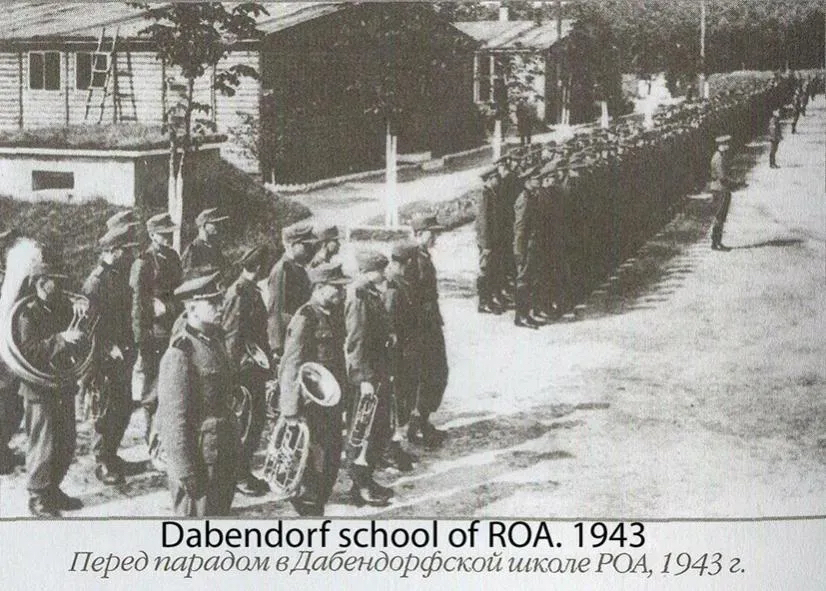
Dabendorf school of ROA. 1943
Source
Source
Chapter Content
The NTS Networks as Infrastructure for the Vlasov Project
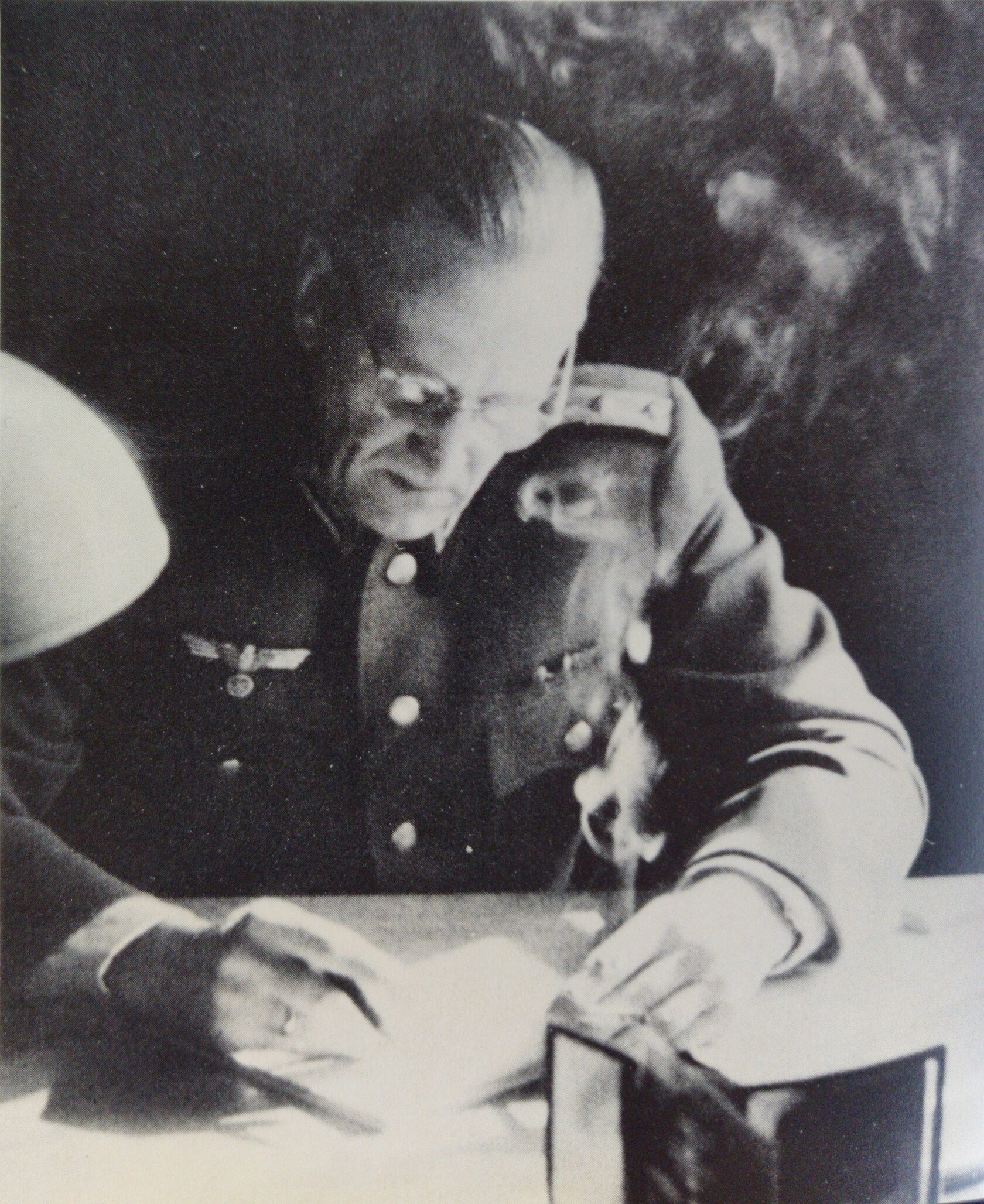
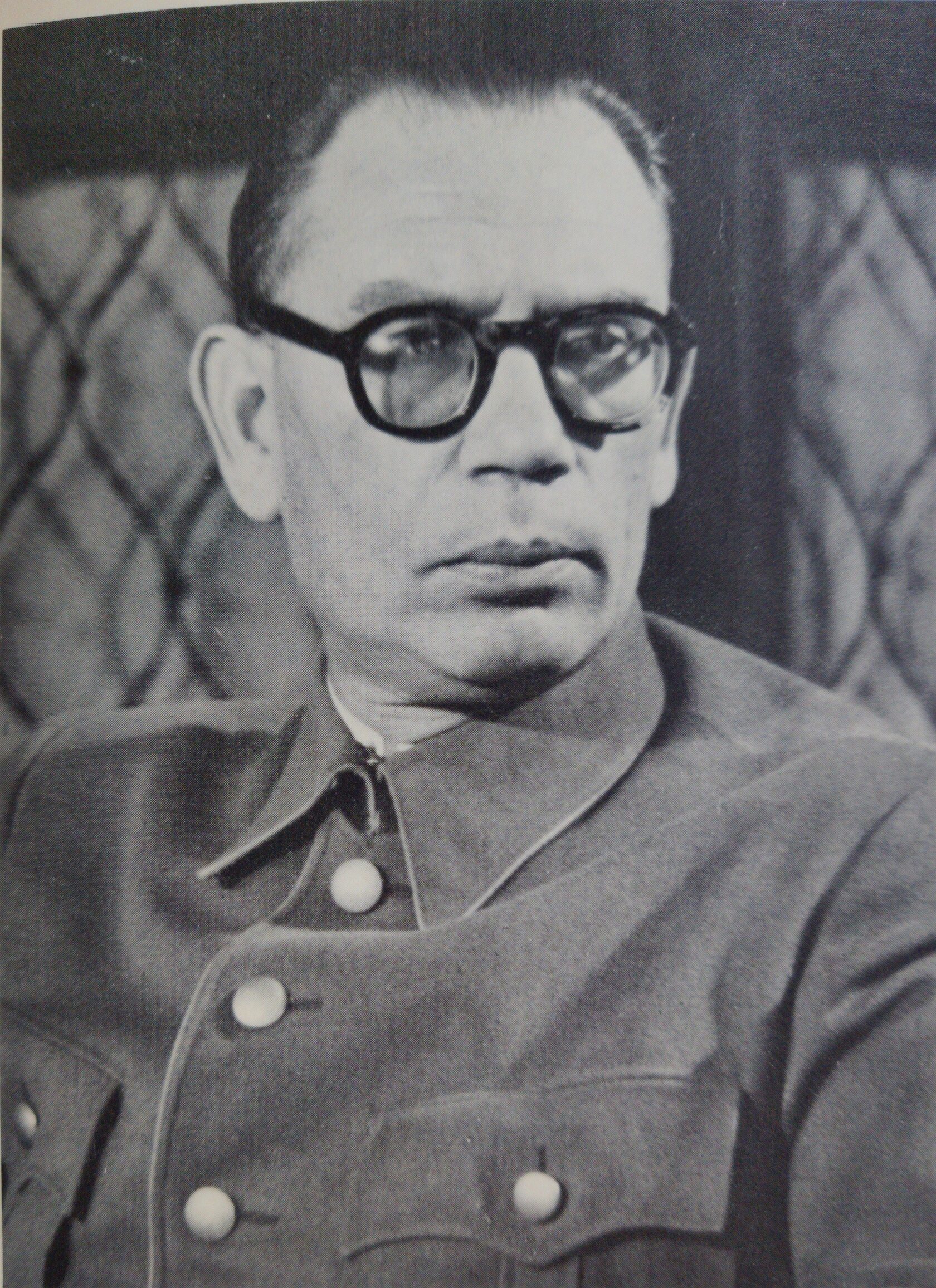
Explore the networks, citations, and documents using the buttons on the right
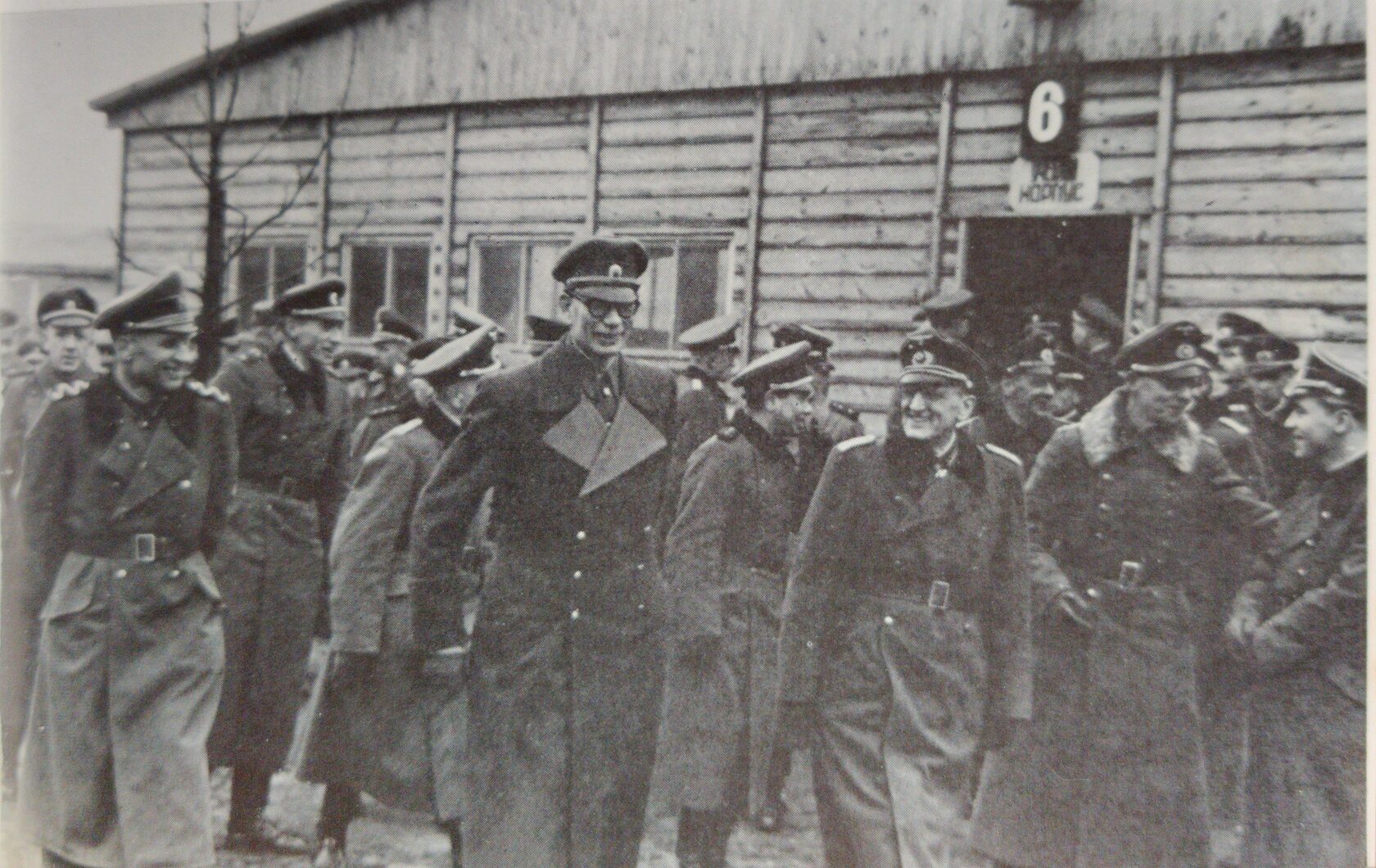
(Front row, left to right) : Malyshkin, Vlasov, Strick-Strickfeldt, von Kleist, Zhilenkov
From: Wilfried Strick-Strickfeldt, Against Stalin and Hitler, MacMillan, 1970
From: Wilfried Strick-Strickfeldt, Against Stalin and Hitler, MacMillan, 1970
General Vlasov announces the KONR Manifesto in German-occupied Prague, November 14, 1944. (Seated, front row, left ro right) : General-Mayor Fedor I. Trukhin, chief of staff ; General-leutenant Georgiy N. Zhilenkov, head of the propaganda department ; Vlasov. (Standing behind, left to right) : Polkovnik Vladimir V. Pozdnyakov, and Polkovnik Igor K. Sacharov. (Tchakov Collection)
From: Nigel Thomas, Hitler’s Russian & Cossack Allies 1941-45, Osprey publishing, 2015
From: Nigel Thomas, Hitler’s Russian & Cossack Allies 1941-45, Osprey publishing, 2015
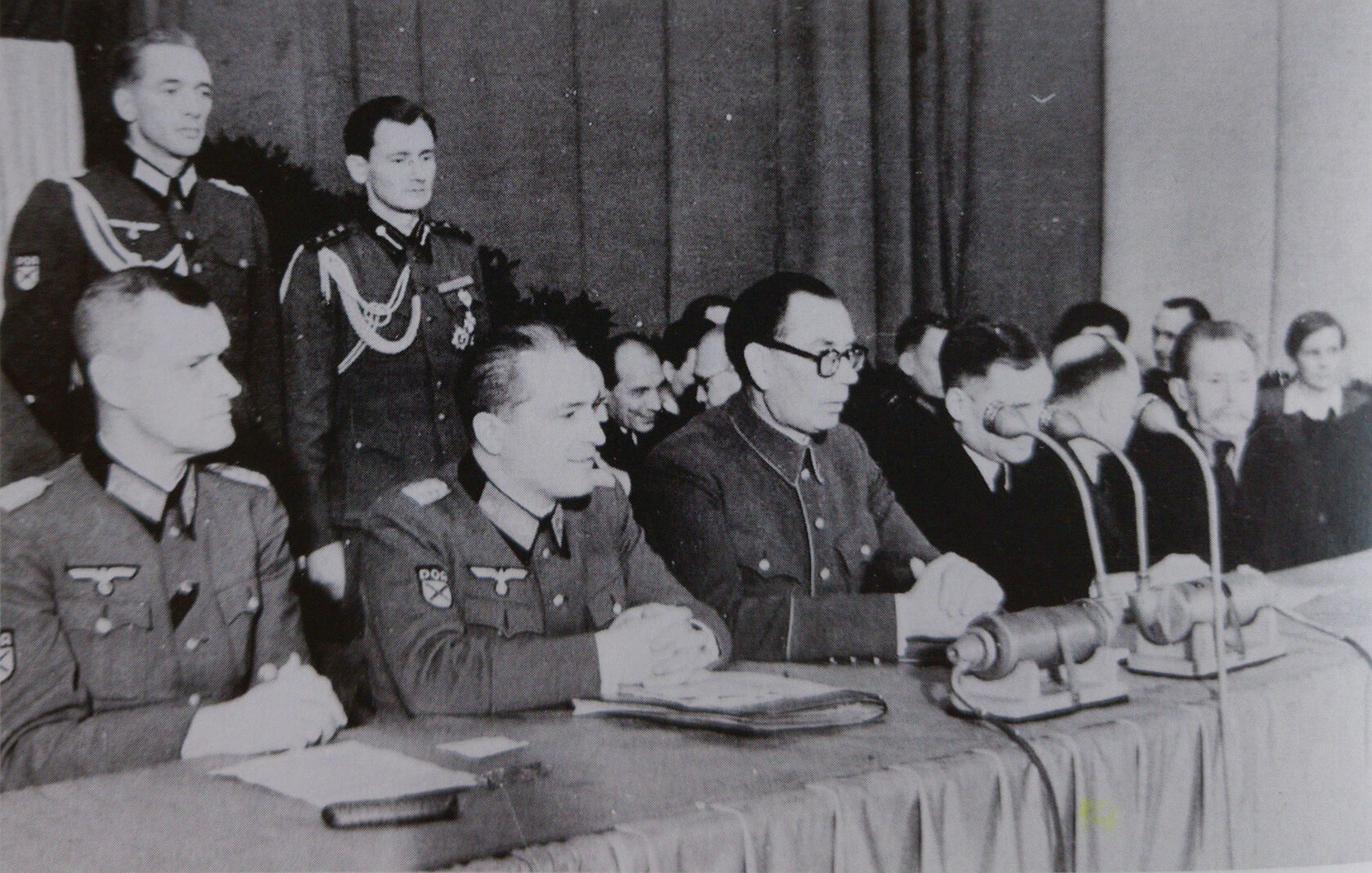


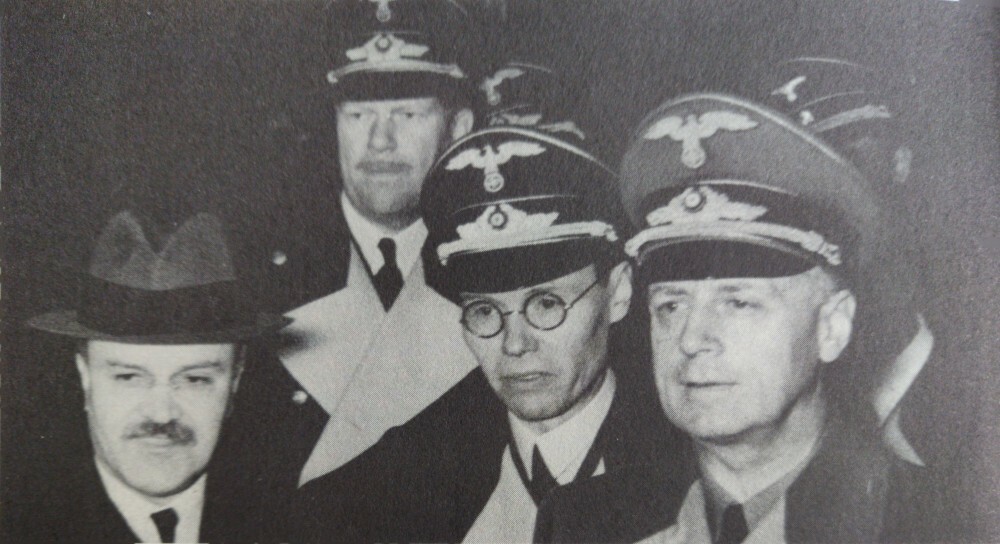
Senior German expert on the USSR Gulstav Hilger (center, in glasses), seen here as first secretary of Germany’s embassy in Moscow during 1939 negotiations of the Hitler-Stalin pact. Soviet minister V. M. Molotov is at the far left ; Nazi Foreign Minister Joachim von Ribbentrop is at right.
From: Christopher Simpson, Blowback, Weidenfeld & Nicolson, 1988
From: Christopher Simpson, Blowback, Weidenfeld & Nicolson, 1988
General Trukhin
From: Wilfried Strick-Strickfeldt, Against Stalin and Hitler, MacMillan, 1970
From: Wilfried Strick-Strickfeldt, Against Stalin and Hitler, MacMillan, 1970
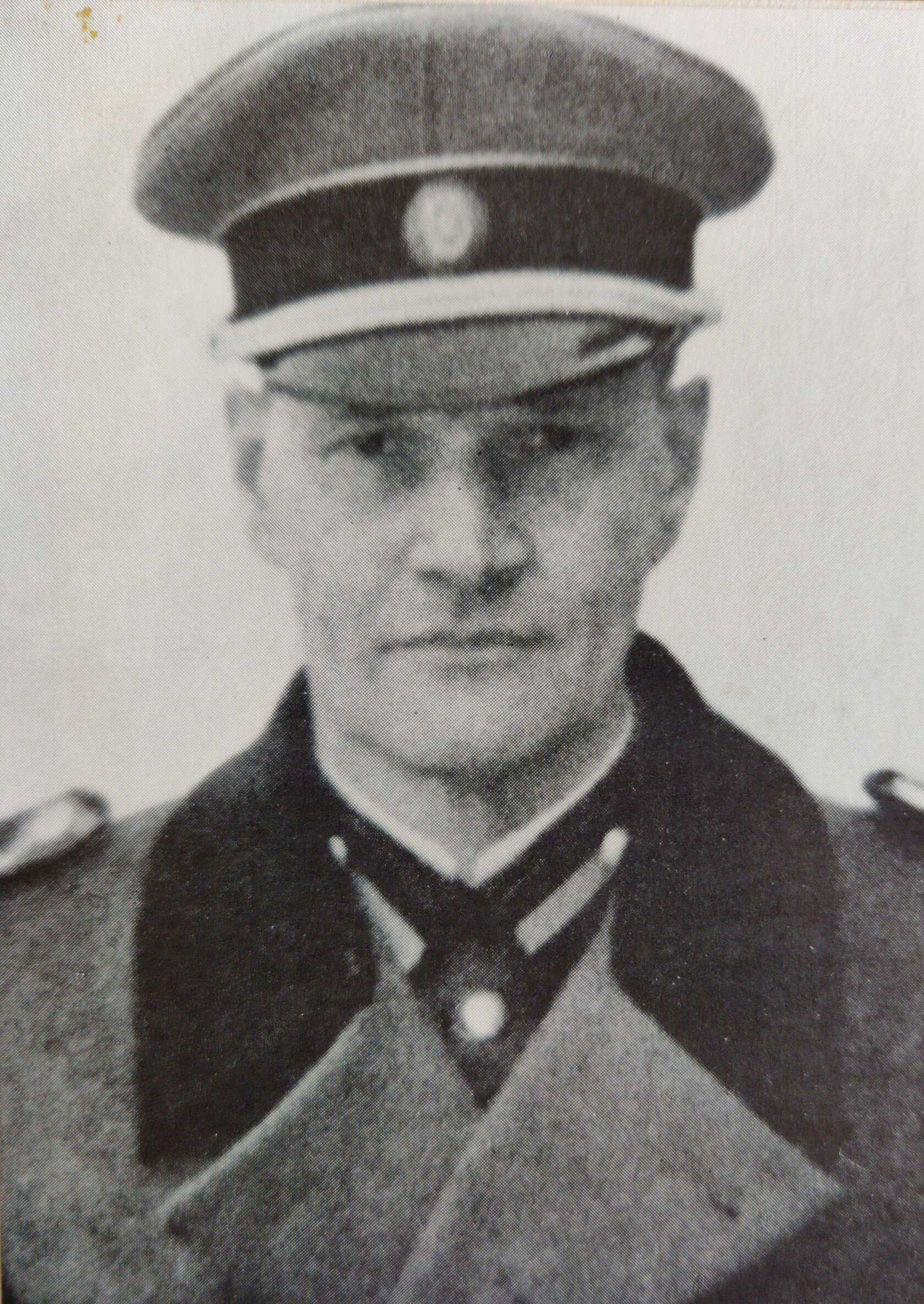
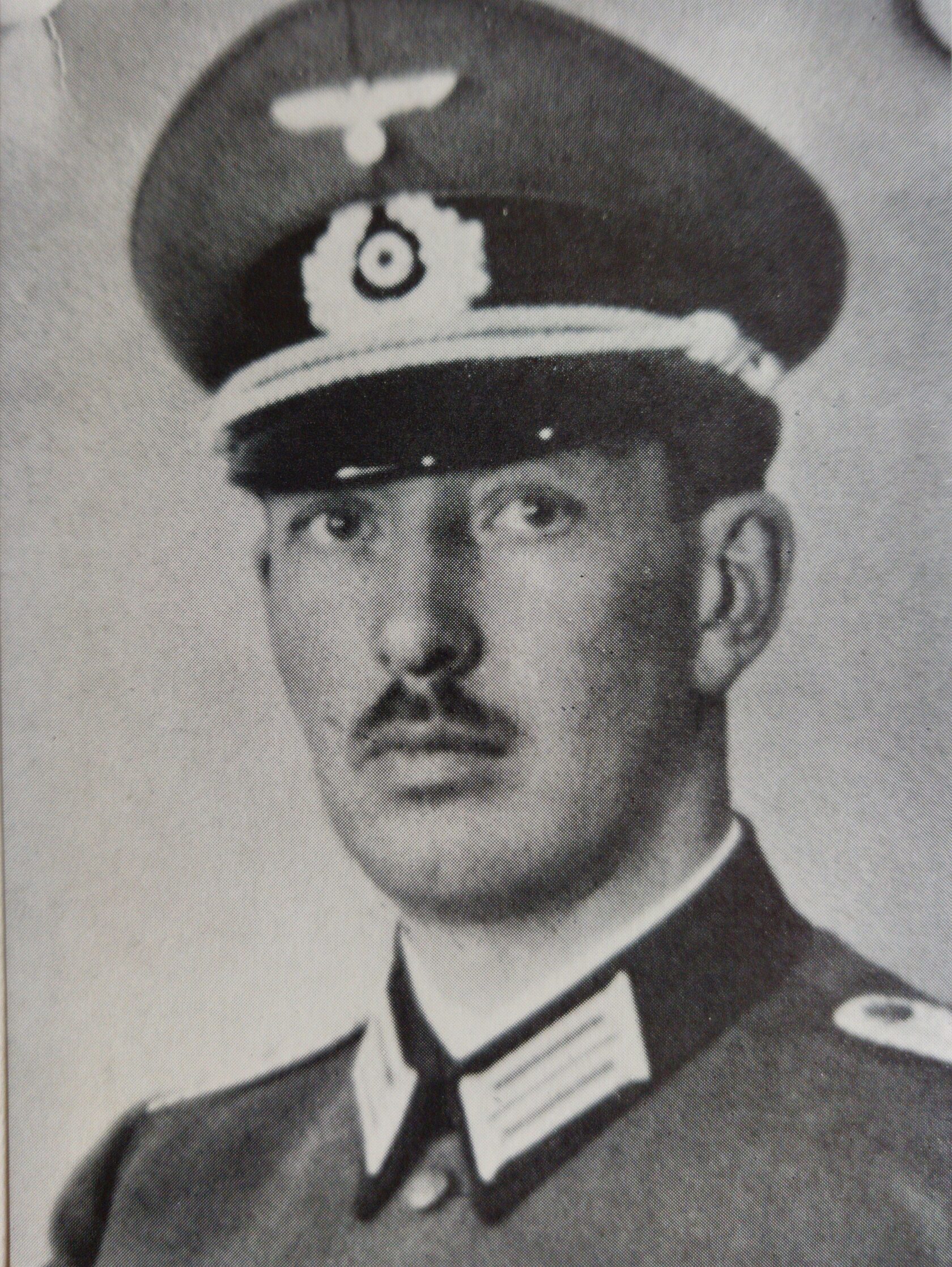
Captain Von Grote
From: Wilfried Strick-Strickfeldt, Against Stalin and Hitler, MacMillan, 1970
From: Wilfried Strick-Strickfeldt, Against Stalin and Hitler, MacMillan, 1970
(Left ro right) Strick-Strickfeldt, unidentified SS officer, d’Alquen, von Dellingshausen, Zykov, Zhilenkov
From: Wilfried Strick-Strickfeldt, Against Stalin and Hitler, MacMillan, 1970
From: Wilfried Strick-Strickfeldt, Against Stalin and Hitler, MacMillan, 1970
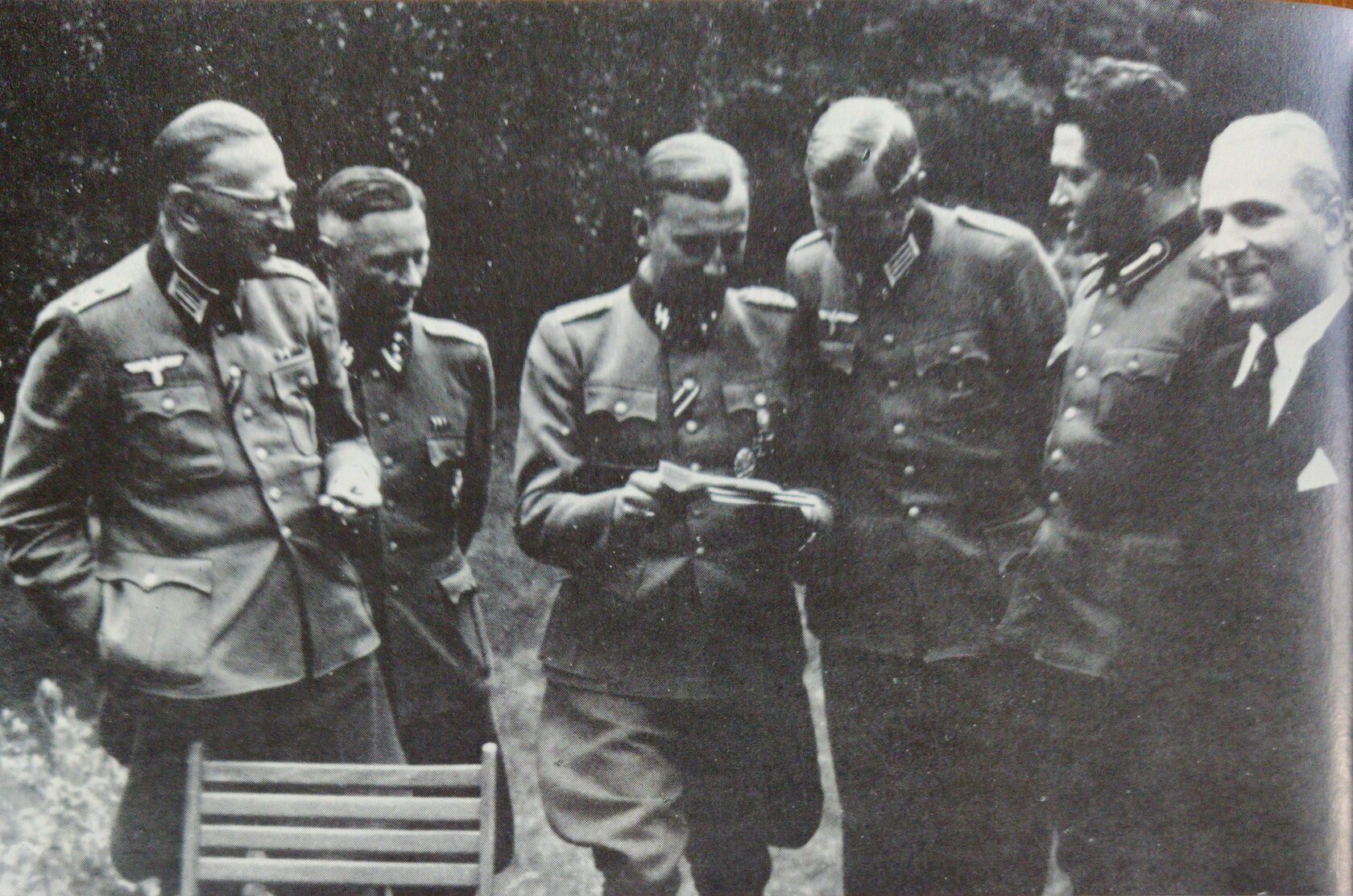
Zhilenkov, Kromiadi and Boyarsky in Pskov, 1943
From: Sven Steenberg, Vlasov, Alfred A. Knopf, 1970
From: Sven Steenberg, Vlasov, Alfred A. Knopf, 1970
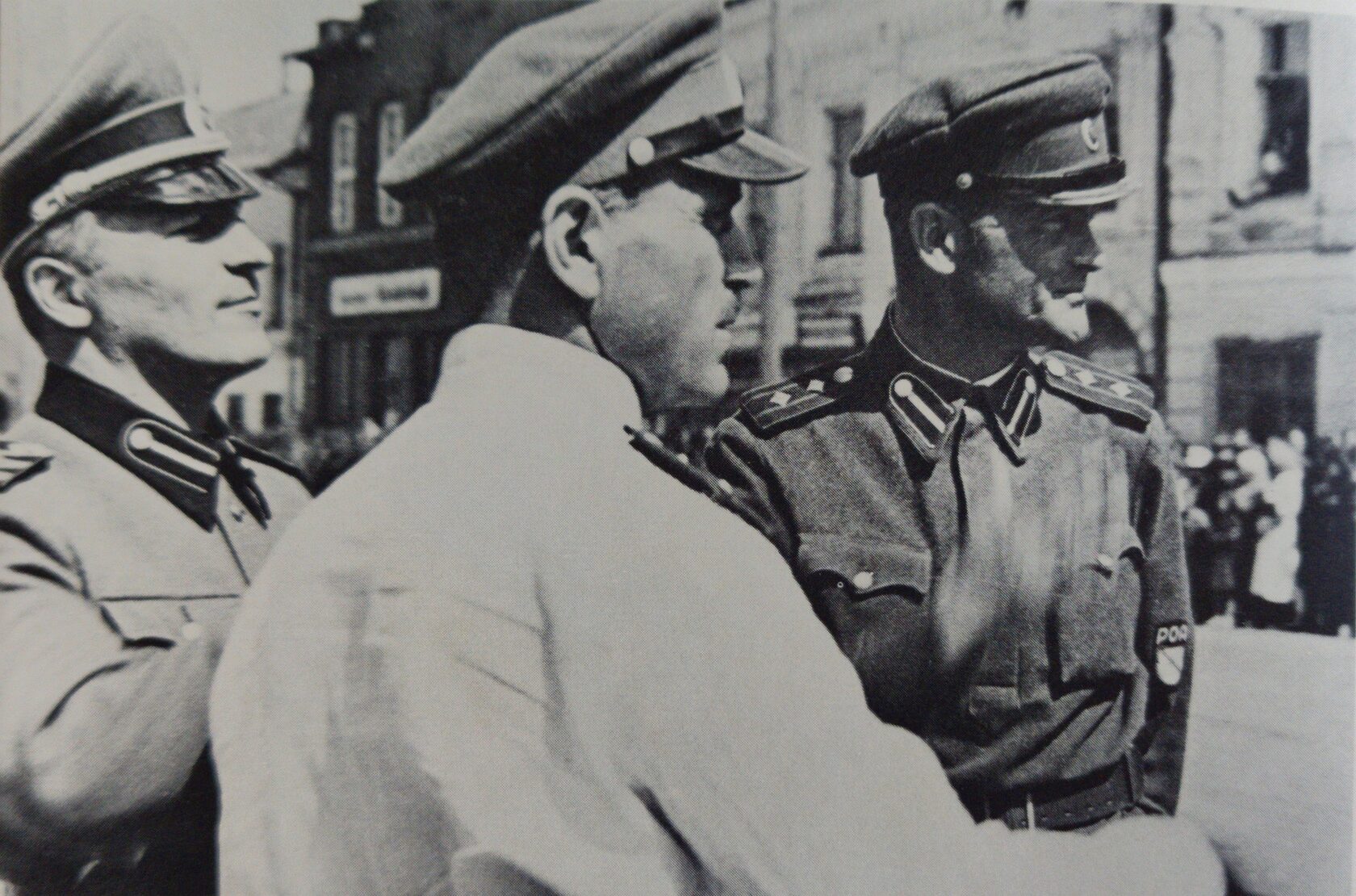
(Left to right) : Vlasov, Zhilenkov, Kroeger, Goebbels
From: Wilfried Strick-Strickfeldt, Against Stalin and Hitler, MacMillan, 1970
From: Wilfried Strick-Strickfeldt, Against Stalin and Hitler, MacMillan, 1970
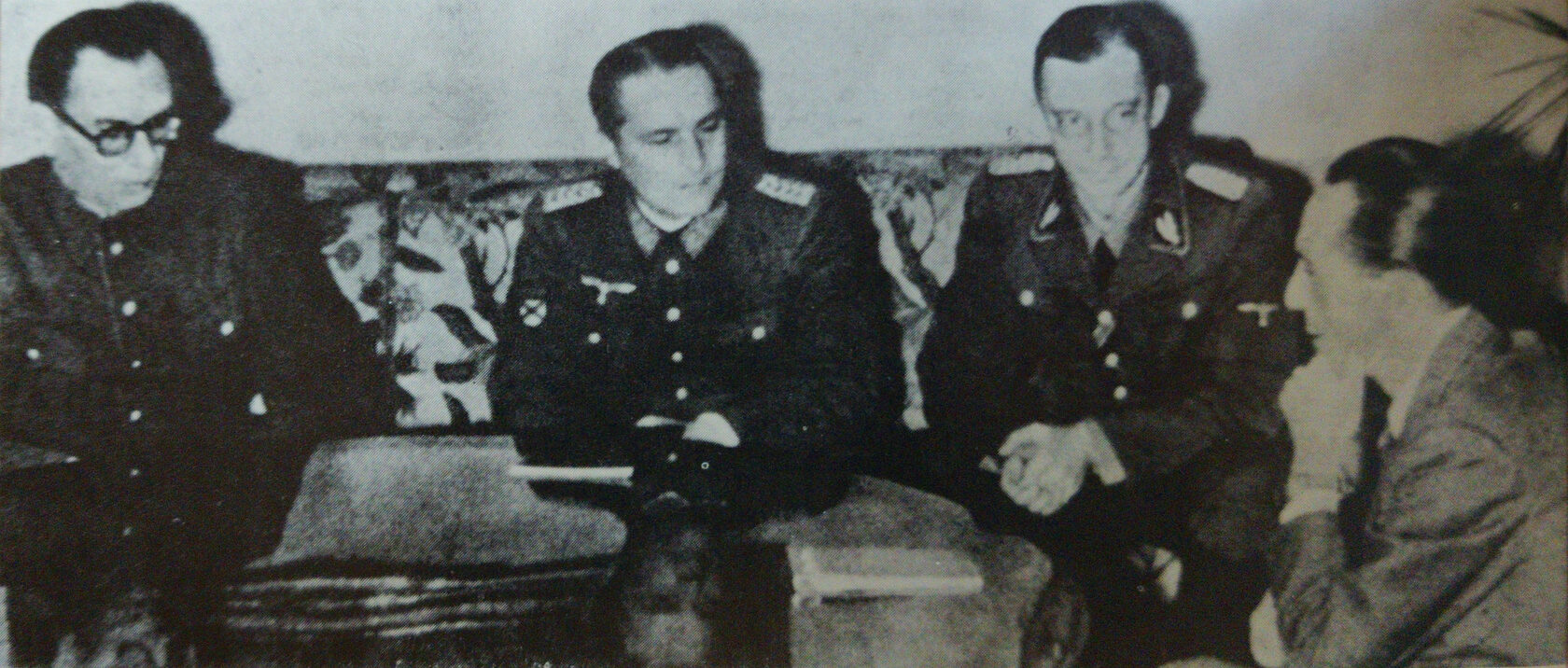

Color reproduction of ROA (Russian Liberation Army) military uniforms (1943-44)
From: Nigel Thomas, Hitler’s Russian & Cossack Allies 1941-45, Osprey publishing, 2015
From: Nigel Thomas, Hitler’s Russian & Cossack Allies 1941-45, Osprey publishing, 2015
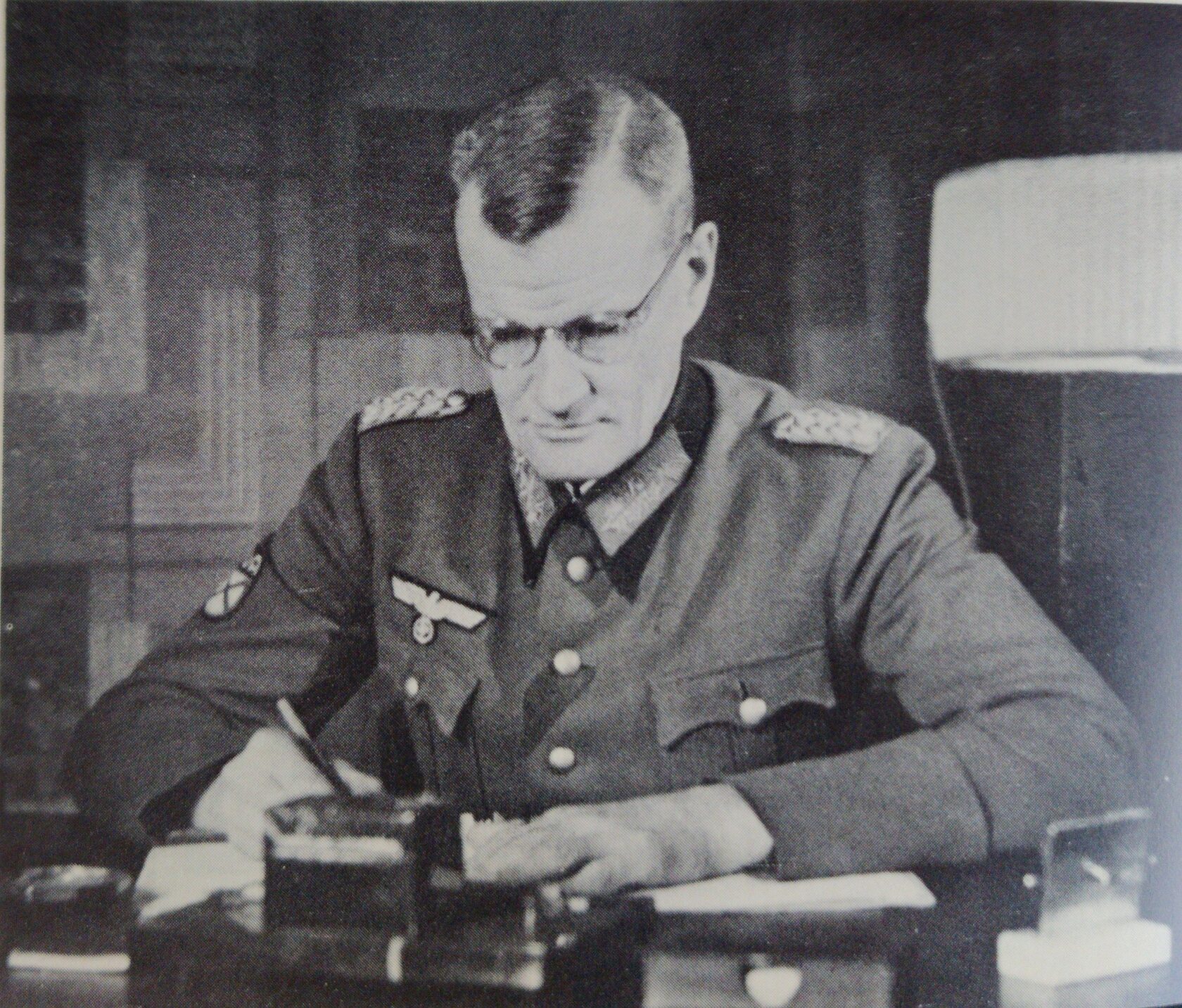
Fedor I. Trukhin
From: Sven Steenberg, Vlasov, Alfred A. Knopf, 1970
From: Sven Steenberg, Vlasov, Alfred A. Knopf, 1970

Color reproduction of KONR Armed Forces uniforms (1945)
From: Nigel Thomas, Hitler’s Russian & Cossack Allies 1941-45, Osprey publishing, 2015
From: Nigel Thomas, Hitler’s Russian & Cossack Allies 1941-45, Osprey publishing, 2015
The White Russians as the Operational Force
behind the Nazis’ Policy in the East
behind the Nazis’ Policy in the East
Content Oriented Web
Make great presentations, longreads, and landing pages, as well as photo stories, blogs, lookbooks, and all other kinds of content oriented projects.

Content Oriented Web
Make great presentations, longreads, and landing pages, as well as photo stories, blogs, lookbooks, and all other kinds of content oriented projects.
Tilda Publishing
Appendix 1
NKVD document on Oleg Klimov
Appendix 2
Poland’s support for Georgian independence and anti-Soviet activities
Interwar Poland and the Intermarium Idea
Appendix 3
Appendix 4
Tilda Publishing
Georgian Collaborationism
Appendix 4
Tilda Publishing
Excerpts of Ruchenko memoirs
Appendix 5
Vineta Operation
Tilda Publishing
A report from the Kiev NKVD surveillance on Herman Strekker
Appendix 6


Content Oriented Web
Make great presentations, longreads, and landing pages, as well as photo stories, blogs, lookbooks, and all other kinds of content oriented projects.
[60] Wilfried Strik-Strikfeldt, Against Stalin and Hitler: Memoir of the Russian Liberation Movement, 1941-1945, trans. David Footman (London: MacMillan, 1970), 66.
[61] Ibid., 69.
[62] Ibid., 70.
[63] Ibid., 75.
[64] Ibid., 78.
[65] Ibid., 82.
[66] Daniel Uziel, “Wehrmacht Propaganda Troops and the Jews,” Yad Vashem Studies 29 (2001): 27-65, https://www.yadvashem.org/articles/academic/wehrmacht-propaganda-troops-and-the-jews.html.
[67] Strik-Strikfeldt, Against Stalin and Hitler, 97.
[68] Ibid., 95.
[69] Ibid., 99.
[70] Another propagandist training camp similar to Wustrau existed in Wulheide, near Berlin, albeit with less NTS involvement. Their trainees were mainly sent to work in the press and radio for Goebbels’ Ministry of Propaganda. The head of training in the Wulheide camp, Baron Georgius von der Ropp, was also recruited in the Dabendorf camp. Ibid., 95, 101.
[71] Slavinsky, Ombres sur le Kremlin, 111.
[72] Federal Archival Agency of Russia, The Vlasov Case (vol. 2), 104-105.
[73] Strik-Strikfeldt, Against Stalin and Hitler, 117.
[74] Federal Archival Agency of Russia, The Vlasov Case (vol. 2), 99.
[75] Savino, “From the White Armies to Nazi Collaboration,” 18.
[76] Strik-Strikfeldt, Against Stalin and Hitler, 116.
[77] Vitaly Chernyavsky, Julius Mader, and Dmitry Prokhorov, Diversanty tret’ego reixha (Moscow: Eksmo-Press, 2004).
[78] Boris Prianishnikoff, “Sonderstaff,” chapter 6 in Novopokolentsy (Silver Spring, MD: Multilingual Typesetting, 1986), 177-180.
[79] Thomas, Hitler’s Russian & Cossack Allies, 19-20.
[80] Sven Steenberg, Vlasov, trans. Abe Farbstein (New York: Alfred A. Knopf, Inc., 1970), 58.
[81] Strik-Strikfeldt, Against Stalin and Hitler, 103.
[82] Ibid., 193-195.
[83] Ibid., 197.
[84] Ibid., 206.
[85] Ibid., 209.
[86] Before 1943, Russian volunteers who enlisted in the German army were required to wear a sleeve patch that displayed the letters “OST,” short for Ostarbeiter. In February 1943, Hitler authorized the creation of a specific military patch for Russians on the Eastern front: it displayed the yellow Cyrillic letters POA (in Latin script ROA, for Russian Liberation Army, Russkaia Osvoboditel'naia Armiia) above the traditional St. Andrew's cross. This insignia was supposed to help maintain the hope that the Russian Liberation Army would be created one day (even if Hitler had expressly vetoed it) and therefore foster Russian loyalty to the Germans. In reality, the ROA remained a series of independent battalions and companies under German command, without cooperation between them. See: Thomas, Hitler’s Russian & Cossack Allies, 8.
[87] Boris Prianishnikoff, “Strike against the Union,” Glava VIII. Udar po Sojuzu in Novopokolentsy (Silver Spring, MD: Multilingual Typesetting, 1986), 184-190.
[88] Strik-Strikfeldt, Against Stalin and Hitler, 211.
[89] Stephen Dorril, MI6: Inside the Covert World of Her Majesty’s Secret Intelligence Service (New York: The Free Press, 2000), 412.
[90] Federal Archival Agency of Russia, The Vlasov Case (vol. 2), 165.
[91] The KONR Armed Forces 1st Intelligence School (also known as the Marienbad School) was established in early 1945 by the KONR Security Department with the approval of the RSHA. See: Federal Archival Agency of Russia, The Vlasov Case (vol. 2), 117 (footnote 97).
[92] NTS member Ivanov was also responsible for the creation, in April 1943, of the so-called Guard Strike Brigade of the RLA, which was under the leadership of the 6th Division of the RSHA. Ibid., 264.
[93] Ibid., 117 (footnote 97).
[94] Ibid., 111, 144.
[95] Ibid., 111.
[96] Slavinsky, Ombres sur le Kremlin, 124.
[97] Boris Prianishnikoff, “The End of the Third Reich,” Glava XIV. Konec Tretʹego rejha in Novopokolentsy (Silver Spring, MD: Multilingual Typesetting, 1986), 216-218.
[98] Slavinsky, Ombres sur le Kremlin, 126.
[99] Simpson, Blowback, 221-223.
[100] Ibid., 224 (footnote).
[101] Slavinsky, Ombres sur le Kremlin, 119.
[102] Ibid., 129-130.
[103] Ibid., 131-132.
[61] Ibid., 69.
[62] Ibid., 70.
[63] Ibid., 75.
[64] Ibid., 78.
[65] Ibid., 82.
[66] Daniel Uziel, “Wehrmacht Propaganda Troops and the Jews,” Yad Vashem Studies 29 (2001): 27-65, https://www.yadvashem.org/articles/academic/wehrmacht-propaganda-troops-and-the-jews.html.
[67] Strik-Strikfeldt, Against Stalin and Hitler, 97.
[68] Ibid., 95.
[69] Ibid., 99.
[70] Another propagandist training camp similar to Wustrau existed in Wulheide, near Berlin, albeit with less NTS involvement. Their trainees were mainly sent to work in the press and radio for Goebbels’ Ministry of Propaganda. The head of training in the Wulheide camp, Baron Georgius von der Ropp, was also recruited in the Dabendorf camp. Ibid., 95, 101.
[71] Slavinsky, Ombres sur le Kremlin, 111.
[72] Federal Archival Agency of Russia, The Vlasov Case (vol. 2), 104-105.
[73] Strik-Strikfeldt, Against Stalin and Hitler, 117.
[74] Federal Archival Agency of Russia, The Vlasov Case (vol. 2), 99.
[75] Savino, “From the White Armies to Nazi Collaboration,” 18.
[76] Strik-Strikfeldt, Against Stalin and Hitler, 116.
[77] Vitaly Chernyavsky, Julius Mader, and Dmitry Prokhorov, Diversanty tret’ego reixha (Moscow: Eksmo-Press, 2004).
[78] Boris Prianishnikoff, “Sonderstaff,” chapter 6 in Novopokolentsy (Silver Spring, MD: Multilingual Typesetting, 1986), 177-180.
[79] Thomas, Hitler’s Russian & Cossack Allies, 19-20.
[80] Sven Steenberg, Vlasov, trans. Abe Farbstein (New York: Alfred A. Knopf, Inc., 1970), 58.
[81] Strik-Strikfeldt, Against Stalin and Hitler, 103.
[82] Ibid., 193-195.
[83] Ibid., 197.
[84] Ibid., 206.
[85] Ibid., 209.
[86] Before 1943, Russian volunteers who enlisted in the German army were required to wear a sleeve patch that displayed the letters “OST,” short for Ostarbeiter. In February 1943, Hitler authorized the creation of a specific military patch for Russians on the Eastern front: it displayed the yellow Cyrillic letters POA (in Latin script ROA, for Russian Liberation Army, Russkaia Osvoboditel'naia Armiia) above the traditional St. Andrew's cross. This insignia was supposed to help maintain the hope that the Russian Liberation Army would be created one day (even if Hitler had expressly vetoed it) and therefore foster Russian loyalty to the Germans. In reality, the ROA remained a series of independent battalions and companies under German command, without cooperation between them. See: Thomas, Hitler’s Russian & Cossack Allies, 8.
[87] Boris Prianishnikoff, “Strike against the Union,” Glava VIII. Udar po Sojuzu in Novopokolentsy (Silver Spring, MD: Multilingual Typesetting, 1986), 184-190.
[88] Strik-Strikfeldt, Against Stalin and Hitler, 211.
[89] Stephen Dorril, MI6: Inside the Covert World of Her Majesty’s Secret Intelligence Service (New York: The Free Press, 2000), 412.
[90] Federal Archival Agency of Russia, The Vlasov Case (vol. 2), 165.
[91] The KONR Armed Forces 1st Intelligence School (also known as the Marienbad School) was established in early 1945 by the KONR Security Department with the approval of the RSHA. See: Federal Archival Agency of Russia, The Vlasov Case (vol. 2), 117 (footnote 97).
[92] NTS member Ivanov was also responsible for the creation, in April 1943, of the so-called Guard Strike Brigade of the RLA, which was under the leadership of the 6th Division of the RSHA. Ibid., 264.
[93] Ibid., 117 (footnote 97).
[94] Ibid., 111, 144.
[95] Ibid., 111.
[96] Slavinsky, Ombres sur le Kremlin, 124.
[97] Boris Prianishnikoff, “The End of the Third Reich,” Glava XIV. Konec Tretʹego rejha in Novopokolentsy (Silver Spring, MD: Multilingual Typesetting, 1986), 216-218.
[98] Slavinsky, Ombres sur le Kremlin, 126.
[99] Simpson, Blowback, 221-223.
[100] Ibid., 224 (footnote).
[101] Slavinsky, Ombres sur le Kremlin, 119.
[102] Ibid., 129-130.
[103] Ibid., 131-132.
